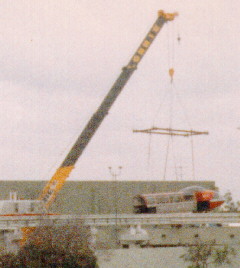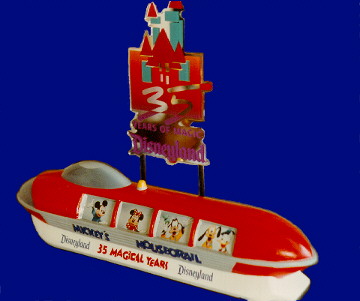
A Profile of Victor Koman's One-Man PR Campaign
to Save Disneyland's Last Mark III Monorail
 A Profile of Victor Koman's One-Man PR Campaign to Save Disneyland's Last Mark III Monorail |
|
|
In 1987, I noticed a change happening in Disneyland. One by one, the old bubbletopped Monorails that I rode and loved as a child and adult were being replaced by new, aircraft-sleek trains. The Mark V monorails — though lovely — did not possess the retro-futuristic look of the Mark III trains. When I asked a monorail operator what the Disney Company was doing with the old trains, he said that the undercarriages were being refurbished to carry the new outer shells, but the old shells were being demolished. I was shocked! After thinking about it and wondering what one man could do to change what was undoubtedly a well-considered corporate decision, I sent a letter Walt Disney Company CEO Michael Eisner, several Disneyland executives, as well as celebrities and other interested parties. I received a reply and encouragement from Walt Disney Attractions President Richard A. Nunis in February. In March, I researched and contacted scores of transportation museums across the country.
|
|
I called my effort "The Incredibly ad hoc Committee to Preserve the World's Last Mark III Monorail" and used my PR abilities acquired through a life-long interest in public speaking, community theater, film, and advertising (not to mention my geriatric Apple ][+ computer) to
|
 Old Red's Last Day -- 18 April, 1988 On 18 April, 1988, Disneyland crew carefully removed the front segment of Monorail Red from its track in front of the roundhouse. (photo taken from Harbor Blvd. overpass by VK) |
 In December, 1989, The Walt Disney Company introduced the refurbished Monorail Red as the street-legal Mouseorail and honored Victor Koman for his efforts in helping to preserve the last Mark III monorail. |
Several Disney executives were kind enough to send letters, including Disney Archivist David R. Smith and then-President and CEO of Walt Disney Company Frank Wells. A year later, I learned of Disney's plans for Monorail Red while flipping through an issue of Disney News. I issued a final press release and thought that would be the end of it. Much to my surprise and pleasure, I was invited to appear on Stephanie Edwards's KCAL TV program LA In The Morning and was interviewed live along with my daughter, Vanessa. Disneyland Goodwill Ambassador Barbara Warren presented me with a one-of-a-kind hand-carved model of the Mouseorail in recognition of my efforts. I was floored! It was a pleasure and an honor to help save Old Red, but to be formally and publicly thanked by the Walt Disney Company was more than I would have hoped or imagined.
|